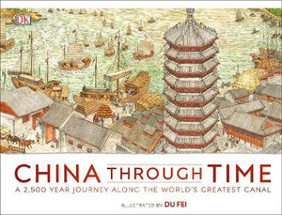China through time retold by Edward Aves

DK, 2020. ISBN: 9780241356296.
(Age: 7+) Highly recommended. Themes: China, Canals, Yangtze,
Ancient history, Regeneration. Two and a half thousand years ago, an
emperor had a brilliant idea - joining the two mighty Chinese
rivers, the Yangtze and Huai to form a magnificent canal which would
enable him to move troops quickly to places where they were needed.
The next thousand yeas saw canals built and waterways joined to
create an incredible canal capable of trading between Hangzhou in
China's south and Beijing in the north.
Each double page of this outstanding large format book recreates a
scene in the life of this canal system, shadowing the rise of China
as a powerful nation in the Asian realm. The first double page,
entitled, Construction begins, Yangzhou 486BCE, shows an army of
peasants digging and carting soil. Information around the edges of
the pages gives details about how the people worked, while the
illustration shows in no uncertain terms the brutality of the regime
in charge. Several men in chains are being taken away by heavily
armoured warriors, one dying man is being carted off by fellow
workers, high towers surround the project with soldiers on the
alert. Eager eyes will pick out the work the men do, the
magnificence of the emperor and his retinue, the tools with which
these people worked.
Each subsequent double page displays the history of the Grand Canal,
completed in 605 CE. So readers will see the impact of the canal
bringing peace, civilisation and trade to towns along its banks. But
people became complacent and in 1699 CE a great flood threatened so
the emperor demanded that the river course be changed and the canal
dredged to avoid further floods destroying towns and cities. More
care was taken of the canal, reversing its decline and even though
fewer barges ply their trade along the waterway the Grand Canal is a
showcase of China's ancient heritage, a canal of some 1800 ks, the
longest and oldest canal in the world. This book shows readers the
people who use it: the builders, the soldiers, merchants, rivermen,
the emperor and his advisers, children and mysterious travellers.
The richly detailed illustrations are enticing, giving the reader a
panorama of Chinese life and customs, showing building styles, dress
and food, bridges and boats, life along the canal from small farms
and villages to the outstanding modern city of Tianjin, a stark
contrast to the pages before and after with their images of past
treasures. The last page offers a short quiz and glossary with
information about the illustrator, Beijing artist Du Fei who
specialises in detailed historical illustrations.
This is a remarkable book which reflects China's importance in the
world today while highlighting one of its past achievements.
Fran Knight